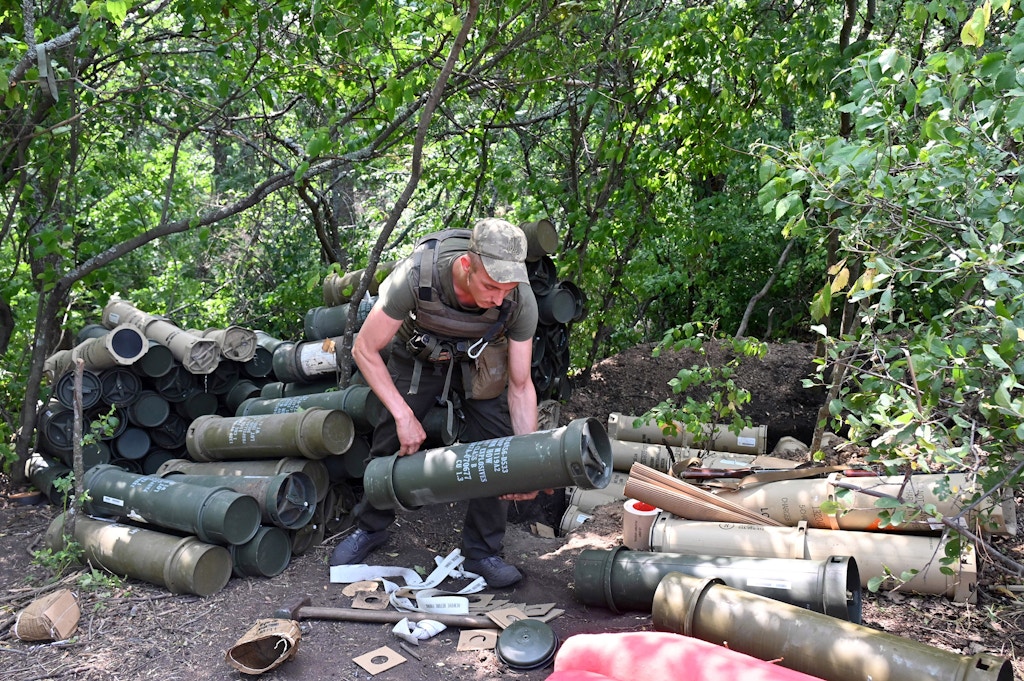Alice Speri,
Ukraine is on track to become the largest recipient of U.S military assistance in the last century. But questions surround the policy.
SINCE RUSSIA’S UNPROVOKED invasion of Ukraine in February, the U.S. government has pumped more money and weapons into supporting the Ukrainian military than it sent in 2020 to Afghanistan, Israel, and Egypt combined — surpassing in a matter of months three of the largest recipients of U.S. military aid in history.
Keeping track of the numbers is challenging. Since the war started, U.S. officials have announced a flurry of initiatives aimed at supporting Ukrainian defense efforts while keeping short of a more direct involvement in the conflict. On Thursday, on a surprise visit to Kyiv, U.S. Secretary of State Antony Blinken announced a new $675 million package of U.S. military equipment as well as a $2.2 billion “long-term” investment to bolster the security of Ukraine and 17 of its neighbor countries. Weeks earlier, President Joe Biden unveiled a $3 billion aid package, the largest yet, symbolically choosing Ukraine’s Independence Day for the announcement. The administration noted on that occasion that the total military assistance committed to Ukraine this year had reached $12.9 billion, more than $15.5 billion since 2014, when Russia annexed Crimea. And this month, Biden also asked Congress to authorize an additional $13.7 billion for Ukraine, including money for equipment and intelligence.
Because the assistance is drawn from a variety of sources — and because it’s not always easy to distinguish between aid that’s been authorized, pledged, or delivered — some analysts estimate the true figure of the U.S. commitment to Ukraine is much higher: up to $40 billion in security assistance, or $110 million a day over the last year. This assistance is believed to be playing an important role in the advances Ukraine is making in an ongoing offensive to retake territory seized by Russia earlier this year; the cities of Kupiansk and Izium are reported to have just been liberated. What is clear is that the volume and speed of the assistance headed to Ukraine is unprecedented, and that legislators and observers are struggling to keep up.
“There is a range of funding sources, including Presidential Drawdown Authority, Foreign Military Financing, and the Ukraine Security Assistance Initiative,” Ari Tolany, U.S. program manager at the Center for Civilians in Conflict, told The Intercept. “It’s been tricky to trace what materiel is coming from where.”
Analysts estimate that Ukraine, already the largest recipient of U.S. security assistance in Europe since 2014, is well on track to become the largest recipient of U.S. security assistance of the century altogether. From World War II Britain to South Vietnam, to the more recent wars in Afghanistan and Iraq, the U.S. government has long conducted foreign policy by supporting, and in some cases building up from scratch, the military capabilities of its allies — often with mixed results. Before the Taliban regained control of Afghanistan last year — two decades after they were ousted from power — the U.S. government spent some $73 billion in military aid to Afghanistan, in addition to billions more it spent on the country’s reconstruction and the $837 billion it spent going to war there. Israel has been the largest cumulative recipient of U.S. foreign assistance since World War II: $146 billion in military assistance and missile defense funding.
There is little precedent for the breakneck pace and scale of U.S. spending on Ukraine. “It’s more than the peak it paid to Afghanistan by a long shot and many times more than aid to Israel,” William Hartung, senior research fellow at the Quincy Institute, told The Intercept. “And it’s somewhat unique that they’ve been arming a country where there are two nation states at war.”
The most recent U.S. military assistance announcements also marked a significant shift in the scope of the U.S. commitment to Ukraine. Earlier packages mostly involved the Defense Department drawing from preexisting stock to quickly equip Ukrainian forces in the face of urgent need — to the tune of $8.6 billion worth of equipment over the last year. The $675 million drawdown announced by Blinken this week marked the 20th time the administration invoked this authority to support Ukrainian defense. The $3 billion package announced by Biden last month, however, involves new contracts with defense manufacturers to produce equipment that will be delivered to Ukraine over months and years, in order to, according to officials, “build the enduring strength of their forces to ensure the continued freedom and independence of the Ukrainian people.”
In other words, as Under Secretary of Defense for Public Policy Colin Kahl put it, this aid is not intended to support Ukraine in “today’s fight” but “for years to come.”
“It’s not like the U.S. is expressing much confidence in its diplomatic skills to end the conflict, rather than just trying to outlast Putin.”
The relentless stream of funding announcements, in the absence of any public discussion of what the U.S. is doing to seek an end to the conflict, has signaled to critics a recognition that there is no end in sight to the war, and that the U.S. is committed to supporting Ukrainian defense efforts for the long haul rather than pursue a negotiated end to it.
“The U.S. is really preparing for a long war. … It’s actually preparing for endless war in Ukraine,” said Stephen Semler, co-founder of the Security Policy Reform Institute, a grassroots-funded U.S. foreign policy think tank that has been tracking the assistance. “They’re saying, ‘We’re only doing this long-term approach because Putin is the one insisting on doing so.’ And that could be right — but at the same time, it’s not like the U.S. is expressing much confidence in its diplomatic skills to end the conflict, rather than just trying to outlast Putin.”
A spokesperson for the State Department wrote in an email to The Intercept that the U.S. is the largest provider of security assistance to Ukraine and has “quickly provided an historic levels [sic] of weapons and equipment that Ukraine’s forces have been using effectively to defend their democracy against Russia’s unprovoked war.”
“Diplomacy is the only way to end this conflict, but Russia has shown no signs that it is willing to seriously engage in negotiations,” the spokesperson added. “We remain committed to supporting a diplomatic settlement and we are currently focused on strengthening Ukraine’s hand as much as possible on the battlefield so that when the time comes, Ukraine has as much leverage as possible at the negotiating table.”
The Defense Department and the Defense Security Cooperation Agency, which works to further U.S. defense and foreign policy goals by building foreign partners’ capacity, did not respond to The Intercept’s requests for comment.
Bubble in Washington
The quick succession of aid announcements and Biden’s request for Congress to authorize an additional $13.7 billion for Ukraine this month have begun to raise questions among legislators. But so far, most of those who have expressed concern about the scale and pace of the aid have focused on calling for enough oversight mechanisms to make sure the weapons are accounted for and don’t end up in the wrong hands, rather than questioning whether the administration should send the aid in the first place, or so much of it so quickly. “At least in the U.S., there’s been very little public criticism of security assistance on the whole,” said Tolany, of Center for Civilians in Conflict.
That’s in part because of the gravity of Russian actions in Ukraine, including widespread evidence of war crimes; the lack of a coherent vision for alternatives to military support for Ukraine, including from European allies; and the Biden administration’s determination to keep U.S. support for Ukraine a material one rather than one involving direct engagement, such as a no-fly zone or American troops on the ground, particularly after a disastrous exit from Afghanistan last year. Questioning U.S. security assistance for Ukraine is seen by many as a controversial stance.
“There’s kind of a bubble in Washington; the conventional wisdom is, give Ukraine almost anything it needs to fight back against Russia,” said Hartung, of the Quincy Institute. He noted that a “line” drawn early on by the Biden administration to avoid Russian escalation and potential nuclear threats — like the exclusion of long-range missiles that can reach into Russia — seemed to be slowly moving. “There seems to be an upper limit, but it seems to be getting higher, what they’re willing to send.”
Ultimately, however, much of the debate in the U.S. lacks a long-term vision, Hartung believes.
“There’s not a lot of support in official circles for trying to push for some kind of negotiated settlement to the war,” he said. The U.S. position, he added, has been “defending Ukraine.” But there’s little clarity about how the assistance is shaping the conflict. “It just a one-liner almost. And not much analysis of, well, does that work? What are the consequences on the ground? Is it going to prolong the war? That stuff is not in the mainstream discussion, and I think there needs to be more debate about that.”

Photo: Sergey Bobok/AFP via Getty Images
Tracking the Weapons
In the absence of more scrutiny of the Biden administration’s end goals in Ukraine, much of the debate in recent months has focused on ensuring that the U.S. can keep track of the security assistance it sends there. Earlier this summer, the Defense Department’s Office of the Inspector General raised concerns about the “transparency and traceability” of funds devoted to Ukraine after Congress rushed to allocate multiple rounds of additional assistance in response to the invasion. The office has been filled on an acting basis for many months — in itself a reason for concern.
The inspector general’s warning came after legislators last spring authorized the U.S. government to devote more than $40 billion to responding to Russia’s invasion of Ukraine through support — ranging from defense equipment to refugee assistance — involving more than half a dozen U.S. agencies. The most recent $3 billion package is part of more than $6 billion approved under that bill for the Defense Department’s special Ukraine Security Assistance Initiative, which supplements conventional avenues through which the U.S. is also boosting Ukrainian military capabilities and those of other “countries impacted by the situation in Ukraine.”
In recent months, legislators have sought to impose some oversight on that massive influx of assistance, including through half a dozen proposed amendments to the defense budget that would introduce measures like congressional reporting requirements, regular briefings to defense and foreign affairs committees, reassurances that weapons would not be provided to extremist groups, and efforts to prevent the illicit distribution of weapons. A number of Republicans have also called for the establishment of a special inspector general tasked with monitoring assistance to Ukraine, and earlier this year, Sen. Rand Paul, R-Ky., single-handedly held up passage of the $40 billion aid package over a similar demand. So far, however, efforts to more robustly monitor the aid have taken second place to getting the aid to Ukraine urgently — a priority that critics note is no longer justified as the latest aid packages signal a much longer-term effort, with plenty of time for better tracking.
In fact, the challenge of tracking where military assistance ends up, and how it is used, is hardly a new one for the U.S. But the sheer scale and speed of the assistance being sent to Ukraine has observers concerned that existing monitoring mechanisms, already riddled with problems, won’t be able to keep up. In recent conflicts, the U.S. lost track of tens of thousands of rifles and pistols it bought for Iraqi security forces, and tens of thousands more pieces of equipment were lost in Afghanistan, frequently ending up in the hands of the Taliban, who loved to display them. Elsewhere, foreign forces who were trained and equipped by the U.S. for “counterterrorism” purposes regularly used their increased capabilities to fight in conflicts unrelated to U.S. security goals, sometimes committing widespread human rights abuses in the process.
U.S. officials’ efforts to track the weapons distributed through security assistance programs across the world have often focused on developing countries — with major recipients like Israel facing little scrutiny even when U.S.-provided equipment was connected to serious violations, including against U.S. citizens. But even in those countries where end-use monitoring is in place, the offices tasked with the job are chronically understaffed. That has raised the alarm about the number of weapons flooding Ukraine in recent months, particularly as Ukraine has historically been a hub in the illicit arms trade, with weapons smuggled through Ukraine ending up in conflicts from Afghanistan to West Africa.
The State Department spokesperson told The Intercept that the administration takes the risk of diversion and illicit proliferation “very seriously.”
“We are actively engaging with the Government of Ukraine to ensure accountability of assistance, even amidst the challenging conflict environment in which it is operating. Despite Russia’s steady drumbeat of false allegations, we see Ukraine’s frontline units effectively utilizing security assistance at large scale every day on the battlefield as they defend their country against Russia’s aggression,” the spokesperson wrote, citing the Ukrainian authorities’ recent announcement of a new commission to strengthen monitoring of donated military equipment. “We will not approve transfers if we assess that a recipient will be unable to adequately secure U.S. origin materiel consistent with the provisions of the underlying agreements supporting the sale or transfer of such equipment.”
Ultimately, critics warn, flooding Ukraine with weapons faster than officials can monitor them presents risks whose full impact won’t be known for years. And while most agree there is a moral imperative to support Ukrainian defense against Russia’s aggression, they note that sending military assistance alone, and boosting military spending across the board, only sets the stage for more conflict.
“If the U.S. is going to send weapons to Ukraine, it has to be in the service of ending the conflict as quickly as possible to prevent further bloodshed.”
“If the U.S. is going to send weapons to Ukraine, it has to be in the service of ending the conflict as quickly as possible to prevent further bloodshed. … There has to be ruthless pursuit of diplomatic engagement, and the Biden administration hasn’t signaled that it’s interested in diplomacy,” said Semler, who also noted that while Ukraine aid is a fraction of the U.S. defense budget, the endless trickle of military assistance risks drumming up support for a broader increase for military spending that is already at historic levels.
“They say, ‘Ukraine needs help, that’s money for us,’ and then, ‘The overall budget needs increasing, because look at Putin, Poland is next, Finland is next, the U.S. has to be prepared,” he added, referring to defense officials. “There’s a moral case for sending weapons [to Ukraine], but as a practical matter, in terms of actually ending the conflict, I just don’t see the effort going in.”
Source: https://theintercept.com
Disclaimer: We at Prepare for Change (PFC) bring you information that is not offered by the mainstream news, and therefore may seem controversial. The opinions, views, statements, and/or information we present are not necessarily promoted, endorsed, espoused, or agreed to by Prepare for Change, its leadership Council, members, those who work with PFC, or those who read its content. However, they are hopefully provocative. Please use discernment! Use logical thinking, your own intuition and your own connection with Source, Spirit and Natural Laws to help you determine what is true and what is not. By sharing information and seeding dialogue, it is our goal to raise consciousness and awareness of higher truths to free us from enslavement of the matrix in this material realm.
 EN
EN FR
FR



























What a BS article. This read like DS propaganda. Some truth and plenty of BS. I have no idea really why the US justifies it's proxy war other than to keep it's war machine in power. No one wants this war or needs it. The pretence is pathetic at best. No one in the west with half a functioning brain believes that Ukraine is innocent and that this is a 'just' war. The prancing fag in power of Ukraine is such an obvious patsy it's sickening. Vlad is doing the world a favour by getting rid of all the evil corruption KM in Ukraine.
This is a good sample of Authentic, or Unauthentic? Social Workers?
NATO HAS BEEN PROVOKING RUSSIA FOR YEARS! FEB. WAS NOT UNPROVOKED!
Meanwhile all this death and destruction serves the predator globalist technocrat ruling class agenda of total slavery and their military/industrial complex laughs all the way to the bank.
Arms dealing drug dealing and human trafficking. The rich making all the money the poor paying the ultimate price in blood. We need to end this insanity. The criminal US Corporation needs to be dissolved once and for all. We The People Never wanted to participate in any of these illegal so called wars.